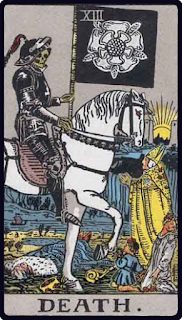
Whilst often mistaken as an omen of forthcoming sorrow or of literal death, the Death card rarely if ever represents either of these. Grief is a transformative process through which we pass when we lose someone or something we love, it is for this reason the Death card represents transformation, endings, and new beginnings. When we experience the death of another, our world changes, leaving behind an old order and replacing it with a new order with no way to return to the way things were.
In the upright state the Death card portends to a period of change where old routines and priorities will shift significantly. Like the Justice card it can relate to any of the four domains of the Tarot and relies upon its placement for context. Death almost never represents a literal death; it is not malicious in nature it is indifferent and serves as a part of life that all humans will eventually meet. Death serves as a sign that we should prepare for change and be willing to embrace the potential in that transformation focusing on the potential destinations rather than the period of tumult during transformation.
In the inverted state the Death card represents a warning of stagnation, asking us to prepare for the possibility that the change we sought may not come, or that it may not come in the form we first expected and must be willing to adapt to this reality.
In the Rider-Waite deck there is a lot of Christian imagery once more. For those familiar with English History the black flag adorned with the White Rose may jump out for its similarity to that of the heraldry of the House of York. The biblical origins of this symbolism relate the White Rose to the Virgin Mary referred to as the Mystical Rose of Heaven.
The presence of the white rose represents the birth onto man of Jesus Christ in juxtaposition to the bottom of the card which depicts a King lying dead on the ground, here signifying the death of Jesus Christ the King of Heaven. Despite first appearing as a scene of a battle, there are no other figures present on the card who are depicted as dead of dying.
The depiction of a King further reinforces the non-literal death alluding to the proclamation “The King is dead, long live the King” called out in tradition as the proclamation of the next in line ascending immediately to the throne. The card further depicts two children one in white and one in blue as descendants of the King representing the line of succession.
Further reinforcing the persistence of presence and preservation of tradition and the unyielding procession of life in the face of death; the Pope is depicted adorned in gold praying to the white horse upon which the spectre of Death rides. It was the Pope in centuries past who crowned the King at their coronation representing the belief in the divine right of Kings to rule over their Kingdoms, their presence here represents the immediacy of transition and transformation poised to crown the heir to the throne.
Death has a transformative effect on the lives of those who survive; in this context it can serve as a useful prompt to look beyond a situation and ask how things will change going forward, to focus on the element of transformation and the opportunity that renewal and reinvention presents. A particular focus should be placed on permanent or irreversible transformations that are life-changing or redefining.
In self-reflection ask yourself “When this is over, what will change?” and consider whether you have the opportunity to shape the outcome of that change. Some things are inevitable and can’t be avoided but we can prepare for those as best we can and put in place whatever we think might help us through those periods of transition.
Living in denial of inevitability does not protect us from its impact, it only shields us from the anxiety that we attach to the anticipation of that inevitability, however it does not free us from the anxiety associated with the inevitability itself. It is for this reason that the things that cause us anxiety cannot be negated through distraction alone. The fear and worry remain on a subconscious level even when we don’t entertain the thoughts on a conscious level - or to put it another way, the elephant in the room can grow bigger the more you ignore its presence.
Grief is the process we go through when we experience a literal death, the same stages are experienced in response to figurative deaths, namely denial, bargaining, anger, depression and acceptance – which can be experienced in almost any order.
Ask yourself “What will I need to help me through this?” with particular reflection on the transformative effect and whether you can accelerate that transformation and shorten the process.

No comments:
Post a Comment
All comments are moderated before they are published. If you want your comment to remain private please state that clearly.